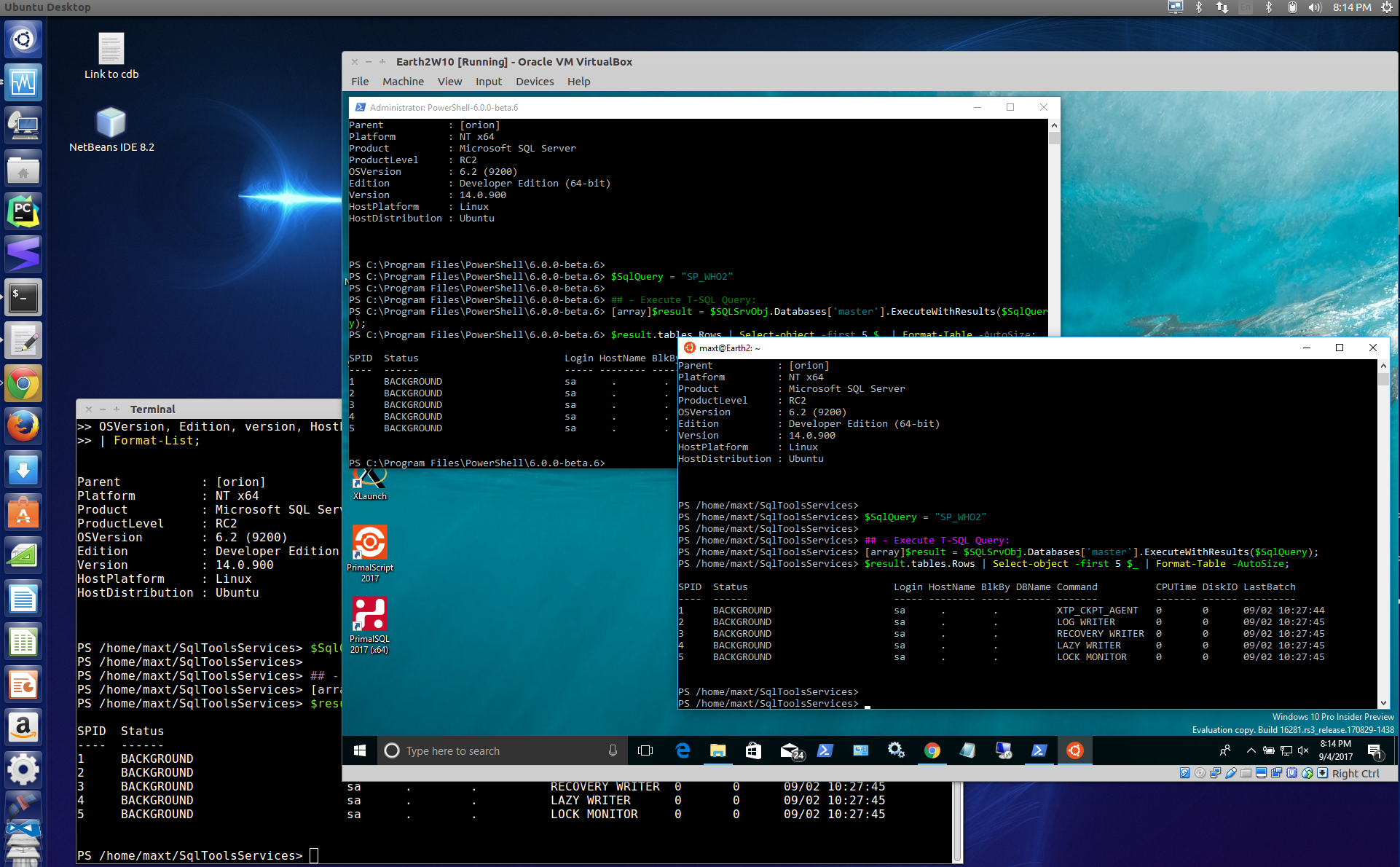Yes! Just recently I downloaded the latest SQL Server SMO assemblies that can be use with PowerShell Core in both Linux and Windows. You can find them in Github under Microsoft SqlToolsService. But, you’ll need to extract only the necessary DLL’s before you can start creating your PowerShell Core SMO scripts. There’s no installation program, as this is installed manually.
There’s one requirement I would suggest to do. Download and install .NET Core 2.0.
To download click this link: https://www.microsoft.com/net/download/core
Manual SMO Installation
The latest SqlToolsService version can be found at this Github link: https://github.com/Microsoft/sqltoolsservice/releases
I’m currently using is V1.1.0-alpha.31.
Just download the file for the OS you’re working:
1. In Windows, download the zip file “Microsoft.SqlTools.ServiceLayer-win-x64-netcoreapp2.0.zip”
a. Open the zip file.
b. In the zip app, select only the following dll’s:
Microsoft.SqlServer.ConnectionInfo.dll
Microsoft.SqlServer.Management.Dmf.dll
Microsoft.SqlServer.Management.Sdk.Sfc.dll
Microsoft.SqlServer.Management.SmoMetadataProvider.dll
Microsoft.SqlServer.Management.SqlScriptPublishModel.dll
Microsoft.SqlServer.Smo.dll
Microsoft.SqlServer.SmoExtended.dll
Microsoft.SqlServer.SqlEnum.dll
Microsoft.SqlServer.SqlParser.dll
NetCoreGlobalization.dll
c. Extract all selected dll’s into your *PowerShell Core Beta folder “C:\Program Files\PowerShell\6.0.0-beta.x”.
2. In Ubuntu Linux, download the tar file “Microsoft.SqlTools.ServiceLayer-ubuntu16-x64-netcoreapp2.0.tar.gz“.
a. To open the file, use either Desktop Nautilus, or use the command-line tar command.
b. In your home folder, create a folder for the dll’s you’re going to extract (for example: mkdir sqltoolsservice).
c. In the tar app, Select only the following dll’s:
Microsoft.SqlServer.ConnectionInfo.dll
Microsoft.SqlServer.Management.Dmf.dll
Microsoft.SqlServer.Management.Sdk.Sfc.dll
Microsoft.SqlServer.Management.SmoMetadataProvider.dll
Microsoft.SqlServer.Management.SqlScriptPublishModel.dll
Microsoft.SqlServer.Smo.dll
Microsoft.SqlServer.SmoExtended.dll
Microsoft.SqlServer.SqlEnum.dll
Microsoft.SqlServer.SqlParser.dll
NetCoreGlobalization.dll
d. Extract the files into the folder you created.
Definitely, using the GUI tar or zip application seems better as you can use the Ctrl key to individually highlight the files to extract.
*Note: Keep in mind, when you add these dll’s into the PowerShell Core folder, uninstalling PowerShell beta won’t removed them. You must manually delete them and the folder.
Verifying SMO Works
In order to test SQLServer Management Objects working with PowerShell Core, we are going to use the following PowerShell Core script snippet:
[sourcecode language=”powershell”]
# – Windows Hack:
cd ‘C:\Program Files\PowerShell\6.0.0-beta.x’
# – Linux Hack:
cd /home/username/SqlToolsServices
# – Loading necessary SMO Assemblies:
$Assem = (“Microsoft.SqlServer.Management.Sdk.Sfc”, `
“Microsoft.SqlServer.Smo”, `
“Microsoft.SqlServer.ConnectionInfo”,
“Microsoft.SqlServer.SqlEnum”);
Add-Type -AssemblyName $Assem
# – Prepare variables for connection strings to SQL Server using SQL Authentication:
$SQLServerInstanceName = ‘Sql01,1451’;
$SQLUserName = ‘sauser’; $sqlPwd = ‘$MyPwd99!’;
## – Prepare connection to SQL Server:
$SQLSrvConn = new-object Microsoft.SqlServer.Management.Common.SqlConnectionInfo($SQLServerInstanceName, $SQLUserName, $SqlPwd);
$SQLSrvObj = new-object Microsoft.SqlServer.Management.Smo.Server($SQLSrvConn);
## – SMO sample 1
## -> Get SQL Server Info:
$SQLSrvObj.Information `
| Select-Object parent, platform, product, productlevel, `
OSVersion, Edition, version, HostPlatform, HostDistribution `
| Format-List;
## – SMO sample 2
## -> To execute T-SQL Query:
# – Prepare query string variable:
$SqlQuery = “SP_WHO2”;
# – Execute T-SQL Query:
[array]$result = $SQLSrvObj.Databases[‘master’].ExecuteWithResults($SqlQuery);
# – Display T-SQL Query results:
$result.tables.Rows | Select-object -first 10 $_ | Format-Table -AutoSize;
[/sourcecode]
When executing the code both Windows and Linux, make sure you are in the folder you installed the dll’s files or it won’t execute.
In Window, in PowerShell Core console stays in folder: “C:\Program Files\PowerShell\6.0.0-beta.x”.
In Ubuntu Linux, in PowerShell Core console, change directory to “SqlToolsService”.
The above script will verify your manual installation of the SMO dll’s in PowerShell Core was successful. Now, you can use SMO in PowerShell Core in both Linux and Windows. And, most important, the previous issue I describe in my previous blog post “PowerShell Core – Getting SQL Server using ADO.NET Data provider” about the DataRow object has been cleared. So, there’s no need for adding code to fix the object to display data columns and values correctly.
Please, go ahead the give it a try! It’s great that now we can use PowerShell Core in Linux to create .NET object we can use and take advantage of this technology.
